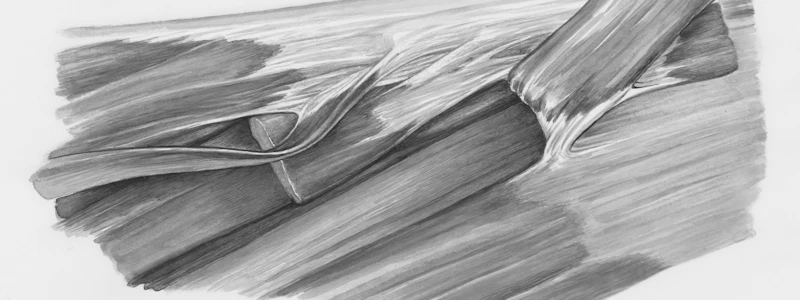Podcast
Questions and Answers
Which muscle is able to generate the largest amount of force in the body?
Which muscle is able to generate the largest amount of force in the body?
- The Hamstrings
- The Iliopsoas
- The Quadriceps
- The Gluteus Maximus (correct)
Which muscle is commonly associated with tightness in individuals with a sedentary lifestyle?
Which muscle is commonly associated with tightness in individuals with a sedentary lifestyle?
- The lumbar spine
- The Iliopsoas (correct)
- The Biceps Femoris
- The Gluteus Medius
What is the deepest layer of the abdominal muscles?
What is the deepest layer of the abdominal muscles?
- Rectus Abdominis
- External Obliques
- Transverse Abdominis (correct)
- Internal Obliques
Which muscle group consists of three muscles?
Which muscle group consists of three muscles?
Which muscle is responsible for raising your foot in a flexed position?
Which muscle is responsible for raising your foot in a flexed position?
Which tendon is considered the strongest in the body?
Which tendon is considered the strongest in the body?
Which condition is associated with a snapping or popping sensation in the joint?
Which condition is associated with a snapping or popping sensation in the joint?
Which direction translates to 'Crossed in Front'?
Which direction translates to 'Crossed in Front'?
Flashcards
What is the strongest muscle in the body?
What is the strongest muscle in the body?
The Gluteus Maximus is the largest and strongest muscle in the human body, responsible for hip extension and external rotation.
Which muscle tightens with a sedentary lifestyle?
Which muscle tightens with a sedentary lifestyle?
The Iliopsoas muscle, which connects the hip and spine, often tightens due to prolonged sitting, causing discomfort and poor posture.
Which muscle group has three muscles?
Which muscle group has three muscles?
The Hamstrings muscle group consists of three muscles: the Biceps Femoris, Semitendinosus, and Semimembranosus. They are located at the back of the thigh and responsible for knee flexion and hip extension.
Which muscle raises your foot in a flexed position?
Which muscle raises your foot in a flexed position?
Signup and view all the flashcards
Which back muscle do you feel working when balancing?
Which back muscle do you feel working when balancing?
Signup and view all the flashcards
What is the deepest layer of the abdominals?
What is the deepest layer of the abdominals?
Signup and view all the flashcards
What should Mrs. Sonia do about her hip pain?
What should Mrs. Sonia do about her hip pain?
Signup and view all the flashcards
Which injury involves a snapping or popping sensation in the joint?
Which injury involves a snapping or popping sensation in the joint?
Signup and view all the flashcards
Study Notes
Muscle Strength and Function
- The quadriceps is the strongest muscle in the body, able to generate significant force.
- The lumbar spine often tightens in people who are sedentary (spend a lot of time sitting).
Muscle Groups
- The hamstrings are a group of three muscles.
Foot Movement
- The tibialis anterior is responsible for lifting the foot in a flexed position.
Back Muscles
- When balancing, pushing down with your arms helps activate back muscles like the trapezius.
Deepest Abdominal Layer
- The deepest layer of the abdominals is the transverse abdominis.
Hip Pain and Dance
- A dancer with hip pain, like Mrs. Sonia, experiencing worsening pain with more intense movements (battements, kicks), should consider seeking medical advice. This may involve temporarily reducing the movements of the affected leg until pain subsides.
Joint Pain and Injuries
- Several injuries can involve a snapping or popping sensation. This includes tendonitis, patellofemoral pain syndrome, a torn achilles, and the snapping hip syndrome. These conditions may require professional diagnosis and treatment.
Strongest Tendon
- The achilles tendon is the body's strongest tendon, located in the lower leg.
True or False Questions
- Arthritis can occur at any age, not just as we get older.
- Fatigue can lead to misalignment and injuries.
Injury Prevention
- To prevent injuries, consider three strategies and their corresponding measures. Examples include proper warm-ups, rest periods, and appropriate stretching.
Choreography Techniques and Modern Dance
- Choreography can be considered both a creative art form and a potential subject of copyright law. It's important to understand the creative and legal issues involved in choreography.
Modern Dance Technique
- Different modern dance techniques have distinct characteristics. Inquiry about a particular technique includes learning about the technique's creator, the technique's elements, and its practical applications in dance.
Ballet Terminology
- "Croisé" in ballet refers to a movement where the body is positioned with one leg crossed in front of the other.
- "Frappe" in ballet describes a specific brushing movement.
Dance Pieces and Choreographers
- Several dance pieces with their corresponding choreographers are listed, namely Revelations, America, and Sugar Plum.
Dance Technique Examples
- Different dance techniques involve specific movements, approaches, and principles. Examples include the firebird, Appalachian Spring, Stormy Weather, One, and Hot Honey Rag, along with their respective creators.
Stretch and Strengthening Exercise
- Hamstring stretches and strengthening exercises can include hamstring stretches and strengthening exercises, that directly target muscles associated with the hamstrings.
Physical Therapy Acronym
- RICE stands for rest, ice, compression, and elevation These principles apply to managing injuries and promoting healing.
Cross Conditioning
- Cross-training is a practice where athletes train in different activities to enhance performance, balance, and overall conditioning. Dance athletes often cross-train to develop additional physical skills and fitness that directly support or complement their specific dance forms.
Pain Reflection
- Reflect on a specific body part experiencing pain in a half-page reflection or more. The reflection should examine the possible causes and describe the actions taken to address the pain, along with outlining any adjustments to future practices or measures that should be considered.
Studying That Suits You
Use AI to generate personalized quizzes and flashcards to suit your learning preferences.




